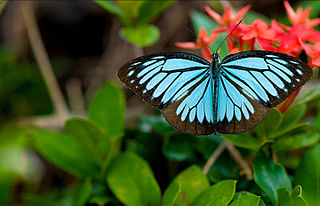
Pareronia valeria, the common wanderer or Malayan wanderer, is a medium-sized butterfly of the family Pieridae, that is, the yellows and whites, and is found in India and Southeast Asia. The butterfly found in India is sometimes considered as a separate species, Pareronia hippia.

Meandrusa sciron, the brown gorgon, is a species of swallowtail butterfly found in parts of South Asia and Southeast Asia. It belongs to the hooked swallowtails genus, Meandrusa, of the family Papilionidae. The brown gorgon is found in India from Sikkim to Assam and north Burma and is not considered to be threatened. Though not uncommon, it is protected under Indian law under the name gyas.

Curetis bulis, the bright sunbeam, is a species of butterfly belonging to the lycaenid family. It is found in Asia.
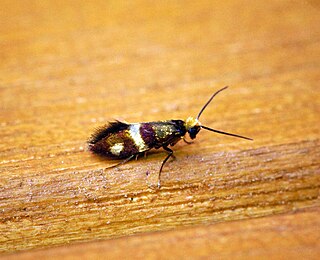
Micropterix aglaella is a species of moth belonging to the family Micropterigidae.It is found in southern France, south-western Switzerland and northern Italy.
Aureopterix micans is a moth of the family Micropterigidae. It is known from dense rainforest throughout New Caledonia from Mount Panié to the Rivière Bleue.

Metacrias strategica is a species of moth in the family Erebidae. This species is endemic to New Zealandwhere it is known from the southern part of the South Island. The female of the species is flightless and pale brown, grey or yellowish-brown in colour where as the male is brightly coloured and flies during the day.

Cosmopterix irrubricata is a moth of the family Cosmopterigidae. It is known from Jamaica and Veracruz, Mexico.
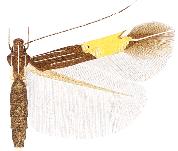
Cosmopterix langmaidi is a moth of the family Cosmopterigidae. It is known from Belize.
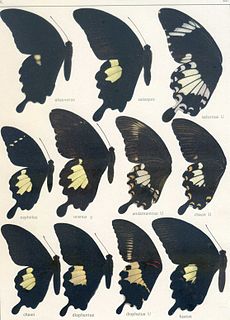
Papilio diophantus is a species of swallowtail butterfly from the genus Papilio that is found in Sumatra.
Alloclita haifensis is a moth in the family Cosmopterigidae. It is found in the Near East and the Middle East.
Maiestas hospes is a species of bug in the family Cicadellidae that can be found in Fiji, Hawaii, New Zealand.
Adelphocoris lineolatus, common names for which are rapid plant bug or superb plant bug, is a species of Hemiptera in the family Miridae, that can be found everywhere in the United States, and in the Peace–Athabasca Delta, Canada. The species are larger than other members of the family, and are either yellowish-black or orange-black coloured.
Porcellio formosus is a species of woodlouse in the genus Porcellio belonging to the family Porcellionidae that can be found in San Pedro and San Francisco of California.
Amplinus bituberculosus is a species of millipede in the family Aphelidesmidae that is endemic to San Vito, Costa Rica, where it was found on 17–18 April 1972.
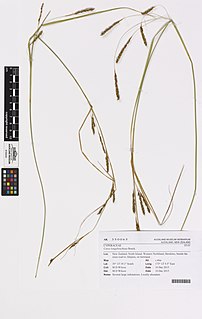
Carex longebrachiata, commonly known as Australian sedge or drooping sedge, is a plant species in the sedge family, Cyperaceae. It is native to Australia.
Melica brasiliana, is a grass species in the family Poaceae that is endemic to Brazil and southern South America.

Bulbothrix cinerea is a species of lichenized fungi within the family Parmeliaceae. Among other Bulbothrix species, only B. isidiza has isidia combined with an underside that is light coloured. B. isidiza's laciniae are wider, while its thallus is pale, and contains salazinic acid. In turn, B. ventricosa is larger and a black underside and rhizinae. The African species B. decurtata is an obligately saxicolous lichen, and while similar, it has a dark underside and produces salazinic acid in its medulla. The species' name thus refers to its uncommon dark gray colouration of its thallus.
Paraulax queulensis is a species of gall wasp. Biology of Paraulax species is unknown but given they are associated with Nothofagus forests their biology is probably associated with the pteromalid gall community. This species is named after the place where it was first collected, Los Queules National Reserve. P. queulensis closely resembles P. perplexa, bearing common traits such as colour, habitus and several morphological characters. P. queulensis differs by having a more elongate body, which in the female is 4 times longer than it is high; its mesosoma is 1.6 times longer than high, while its metasoma is 1.9 times longer than high. The mesosoma is more dorsoventrally depressed. Its pronotum s 1.5 times longer laterally than high. It possesses longitudinal costulae running from the lateral margin of its pronotal plate to its lateral surface. Its scutellar foveae is discernible even when shallow. The antenna also differs: the pedicel of the female antenna is 1.4 times longer than wide.
Paraulax ronquisti is a species of gall wasp. Biology of the Paraulax species is unknown but given they are associated with Nothofagus forests their biology is probably associated with the pteromalid gall community. It is named in honour of Fredrik Ronquist. This species differs from P. perplexa and P. queulensis by its body's red-brown color, the shape of the antennal flagellomeres F3 and F4, the faint notauli and its smooth and shiny mesopleuron. It has an elongated body like P. queulensis.

Hylaeus agilis, commonly known as the Agile masked bee, is a bee species in the family Colletidae. It is endemic to New Zealand. This species is found throughout the country and visits the flowers of a wide variety of plant species, both native and introduced.









